Laboratory Investigation of the Low-Temperature Crack Resistance of Wood Tar-Based Rejuvenated Asphalt Mixture Based on the Semi-Circular Bend and Trabecular Bending Test
Abstract
1. Introduction
- (1)
- Establish a damage creep model to describe the bending creep properties of a rejuvenated asphalt mixture at low temperatures based on the creep relaxation characteristics and laboratory test results of rejuvenated asphalt mixture at low temperatures.
- (2)
- Comprehensively evaluate the road performance of wood tar-based rejuvenated asphalt and promote the practical application of wood tar-based rejuvenated asphalt.
2. Materials and Methods
2.1. Base Materials
2.1.1. Asphalt
2.1.2. Rejuvenator
2.2. Preparation of Rejuvenated Asphalt
2.3. Aggregrates
2.4. Mix Design of Asphalt Mixture
2.5. Experiments
2.5.1. BBR Test
2.5.2. SCB Test
2.5.3. Trabecular Bending Test
2.5.4. Trabecular Bending Creep Test
3. Results and Discussion
3.1. BBR Test Result
3.1.1. Creep Stiffness and Creep Rate
3.1.2. Continuous Low-Temperature Classification Temperature
3.2. SCB Test Results
3.3. Trabecular Bending Test
3.4. Trabecular Bending Creep Test
3.5. Creep Damage Model
4. Conclusions
- (1)
- Compared with the original asphalt, wood tar-based rejuvenated asphalt had lower creep stiffness and higher creep slope. The low temperature classification of wood tar-based rejuvenated asphalt was basically in the same grade as original asphalt and RA-102 rejuvenated asphalt.
- (2)
- The low-temperature crack resistance of the wood tar-based rejuvenated asphalt mixture was obviously better than that of the RA-102 rejuvenated asphalt mixture, but slightly worse than the original asphalt mixture. After combining wood tar and biomass fiber, wood tar can fully permeate the new asphalt, effectively alleviating the bond failures between asphalt and aggregates and improving the stiffness of the mixture, so that the toughness and crack resistance of the rejuvenated asphalt mixture at low temperatures are improved.
- (3)
- The established creep damage model could better describe the flexural creep performance of rejuvenated asphalt mixtures at low temperatures, and could be used to infer the deformation characteristics at other temperatures.
- (4)
- The creep damage model established in this study could be effectively extended to the study of low-temperature crack resistance of other types of recycled asphalt mixtures. Due to the wide source of raw materials and green environmental protection, wood tar-based rejuvenator has big potential to be promoted and applied in this way, which could effectively replace the extraction oil rejuvenator.
- (5)
- In later stages, we plan to analyze the low-temperature cracking resistance of the reclaimed asphalt mixture from the mechanism of wood tar-based regenerating agents on aging asphalt at the micro-nano level.
Author Contributions
Funding
Institutional Review Board Statement
Conflicts of Interest
References
- Liu, J.; Zhao, S.; Li, L.; Li, P. Low temperature cracking analysis of asphalt binders and mixtures. Cold. Reg. Sci. Technol. 2017, 141, 78–85. [Google Scholar] [CrossRef]
- Motevalizadeh, M.; Sedghi, R.; Rooholamini, H. Fracture properties of asphalt mixtures containing electric arc furnace slag at low and intermediate temperatures. Constr. Build. Mater. 2020, 240, 117965. [Google Scholar] [CrossRef]
- Rdland, E.S.; Samanipour, S.; Rauert, C. A novel method for the quantification of tire and polymer-modified bitumen particles in environmental samples by pyrolysis gas chromatography mass spectroscopy. J. Hazard. Mater. 2022, 423, 127092. [Google Scholar] [CrossRef] [PubMed]
- Min, J.C.; Yong, J.K.; Hyeok, J.K. Performance evaluation of the use of tire-derived fuel fly ash as mineral filler in hot mix asphalt concrete. J. Traffic Transp. Eng. 2020, 7, 249–258. [Google Scholar]
- Yin, J.; Wang, S. Improving the performance of asphalt mixture by addition of short-thin wheat straw pieces. Int. J. Pave. Res. Eng. 2016, 17, 528–541. [Google Scholar] [CrossRef]
- Zhang, J.; Zheng, M.; Pei, J.; Zhang, J.; Li, R. Research on low temperature performance of emulsified asphalt cold recycled mixture and improvement measures based on fracture energy. Materials 2020, 13, 3176. [Google Scholar] [CrossRef] [PubMed]
- Hao, L.; Liu, Y.; Xiao, J. Durability of recycled aggregate thermal insulation concrete under combined flexural loading and freeze–thaw cycles. Constr. Build. Mater. 2020, 272, 121652. [Google Scholar] [CrossRef]
- Wang, L.; Pei, K.; Li, C. On rheological properties and constitutive relationship of polyphosphoric acid-SBS composite modified asphalt mixture at low temperature. J. Build. Mater. 2021, 24, 842–850. [Google Scholar]
- Li, Y.; Chang, C.Q.; Zhang, J.Q. Experimental studies on viscoelastic characteristics of compound crumb rubber modified asphalt mixture based on trabecular bending creep test. J. Inn. Mong. Agric. Univ. (Nat. Sci. Ed.). 2014, 35, 115–119. [Google Scholar]
- Liu, J.; Xia, Y.; Yuan, J. Technological properties of poplar residues functionalized powder. J. Cent. S. Univ. For. Technol. 2019, 39, 139–144. [Google Scholar]
- Xu, Y.; You, Z.; Dai, Q.; Mills, J. Mechanical performance of asphalt mixtures modified by bio-oils derived from waste wood resources. Constr. Build. Mater. 2014, 51, 424–431. [Google Scholar]
- Zhang, X.; Zhu, J.; Wu, C.; Wu, Q.; Jiang, K. Preparation and properties of wood tar-based rejuvenated asphalt. Materials 2020, 13, 1123. [Google Scholar] [CrossRef] [PubMed]
- Liu, C.; Du, J.; Wu, C.; Liu, K.F.; Jiang, K. Low-Temperature Crack Resistance of Wood Tar-Based Rejuvenated Asphalt Based on Viscoelastic Rheological Method. Int. J. Pave. Res. Technol. 2021, 7, 1–14. [Google Scholar] [CrossRef]
- Feng, D.C.; Cui, S.D.; Yi, J.Y. Evaluation index of low-temperature asphalt mixture performance based on semi-circular bending test. China J. Highw. Transp. 2020, 7, 50–57. [Google Scholar]
- Li, L. Study on the low temperature and fatigue performance of waste tire rubber modified asphalt mixture. Master’s Thesis, Changan University, Xi’an, China, June 2012. [Google Scholar]
- Zhang, J.; Huang, W.; Lv, Q. Low temperature performance of TB crumb rubber composite SBS modified asphalt mixture. J. Build. Mater. 2021, 24, 152. [Google Scholar]
- Gen, H.; Li, L.; Zhang, L. Indicators for low temperature cracking resistance of high modulus asphalt binders. J. Build. Mater. 2018, 21, 98–103. [Google Scholar]
- Xiong, G.; Zhang, H. Study on road perfoormance test of basalt fiber asphalt mixture. Technol. Highw. Transp. 2016, 32, 26–30. [Google Scholar]
- Li, Z.; Shen, A.; Guo, Y. Low temperature performance correlation of basalt fiber asphalt mortar and mixture. J. Build. Mater. 2021, 24, 146–152. [Google Scholar]
- Lou, K.; Kang, A.; Xiao, P.; Wu, Z.; Wang, X. Effects of basalt fiber coated with different sizing agents on performance and microstructures of asphalt mixture. Constr. Build. Mater. 2021, 266, 121155. [Google Scholar] [CrossRef]
- Yu, X.; Huang, J.B. Study on low-temperature performance of asphalt mixture impacted by modified asphalt and polyester fibers. Appl. Mech. Mater. 2012, 204–208, 3886–3889. [Google Scholar] [CrossRef]
- Chen, G.X.; Yin, Y.P.; Luo, Y.F. Effect of baslat fiber on performance of steel slag-asphalt mixture. Bull. China Ceram. Soc. 2022, 41, 657–666. [Google Scholar]
- Cheng, Z.Q.; Sheng, F.; Hou, L.J.; Zhou, X.Y.; Zhao, X.C.; Gao, S.L. Effect of basalt fiber content on the road performance of large-void asphalt mixture. J. Mater. Sci. Eng. 2021, 39, 736–744. [Google Scholar]
- Zhao, H.; Guan, B.; Xiong, R. Investigation of the performance of basalt fiber reinforced asphalt mixture. Appl. Sci. 2020, 10, 1561. [Google Scholar] [CrossRef]
- Zeng, G.; Yang, X.; Yin, A.; Mo, J. Experimental researches on damage creep model of asphalt mixture. J. Wuhan Univ. Sci. Technol. 2011, 5, 364–367. [Google Scholar]
- Zhang, J.; Huang, X.; Ma, T. Damage-creep Characteristics and Model of Asphalt Mixture. China J. Geotech. Eng. 2008, 30, 1867–1871. [Google Scholar]

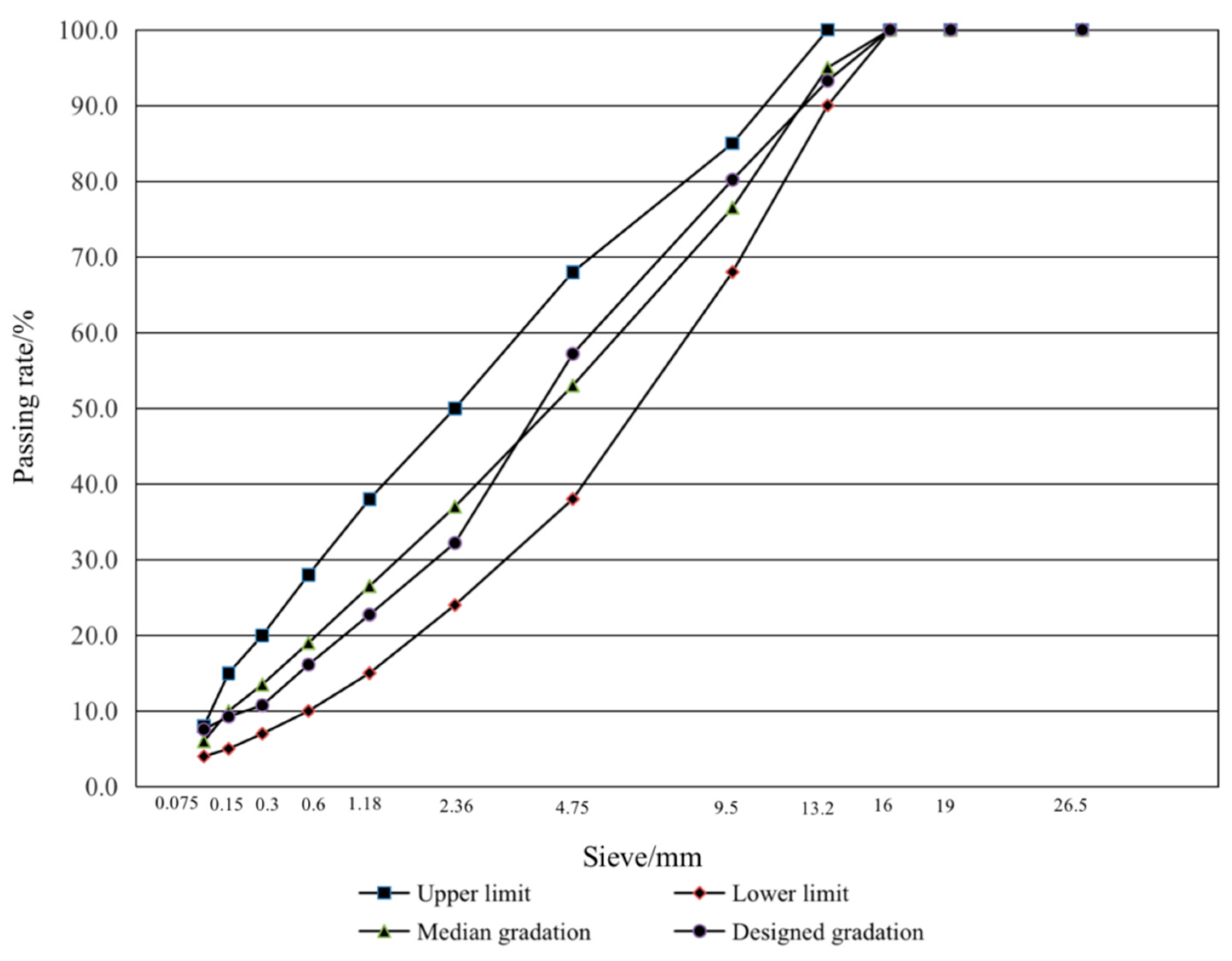
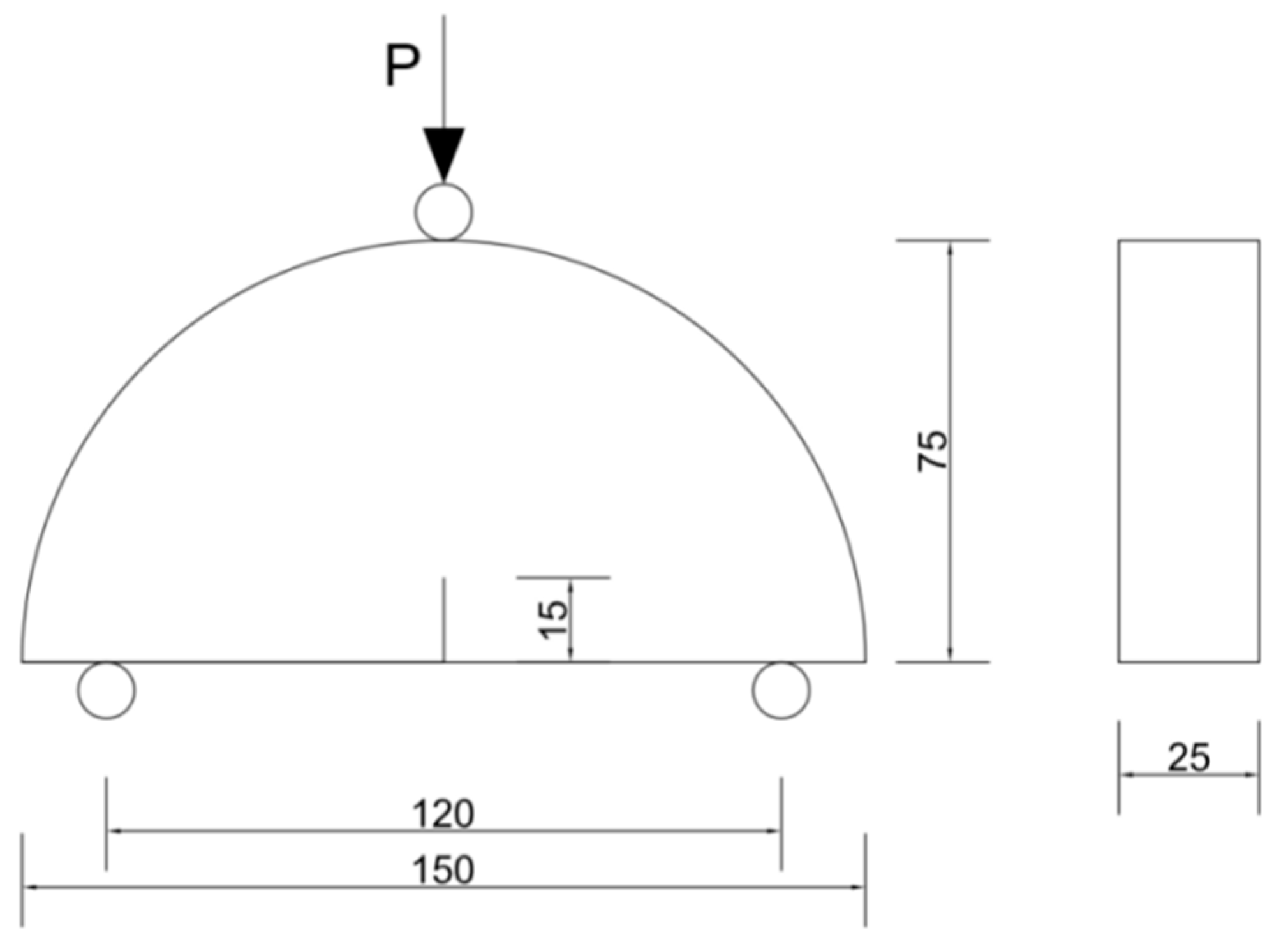
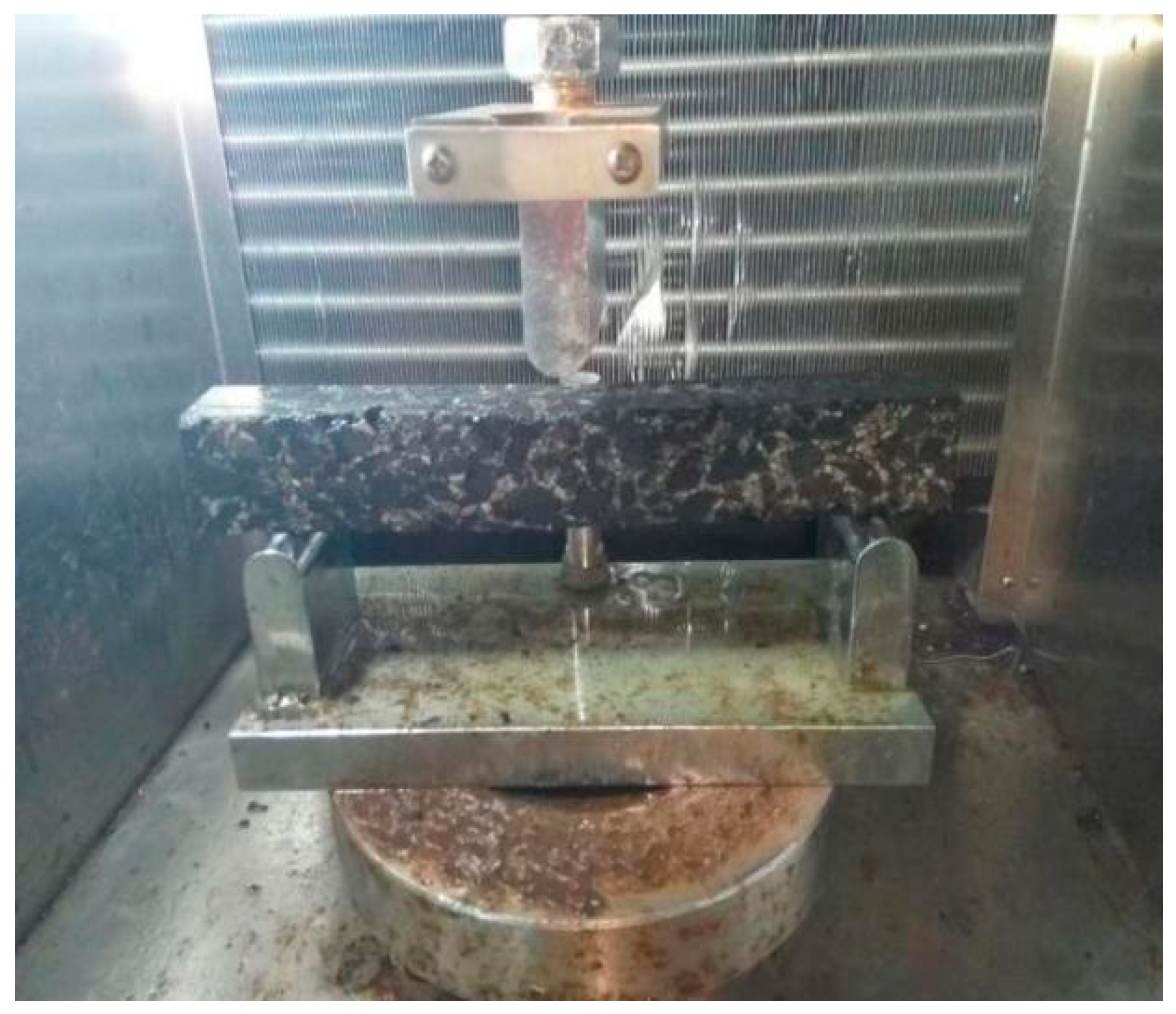
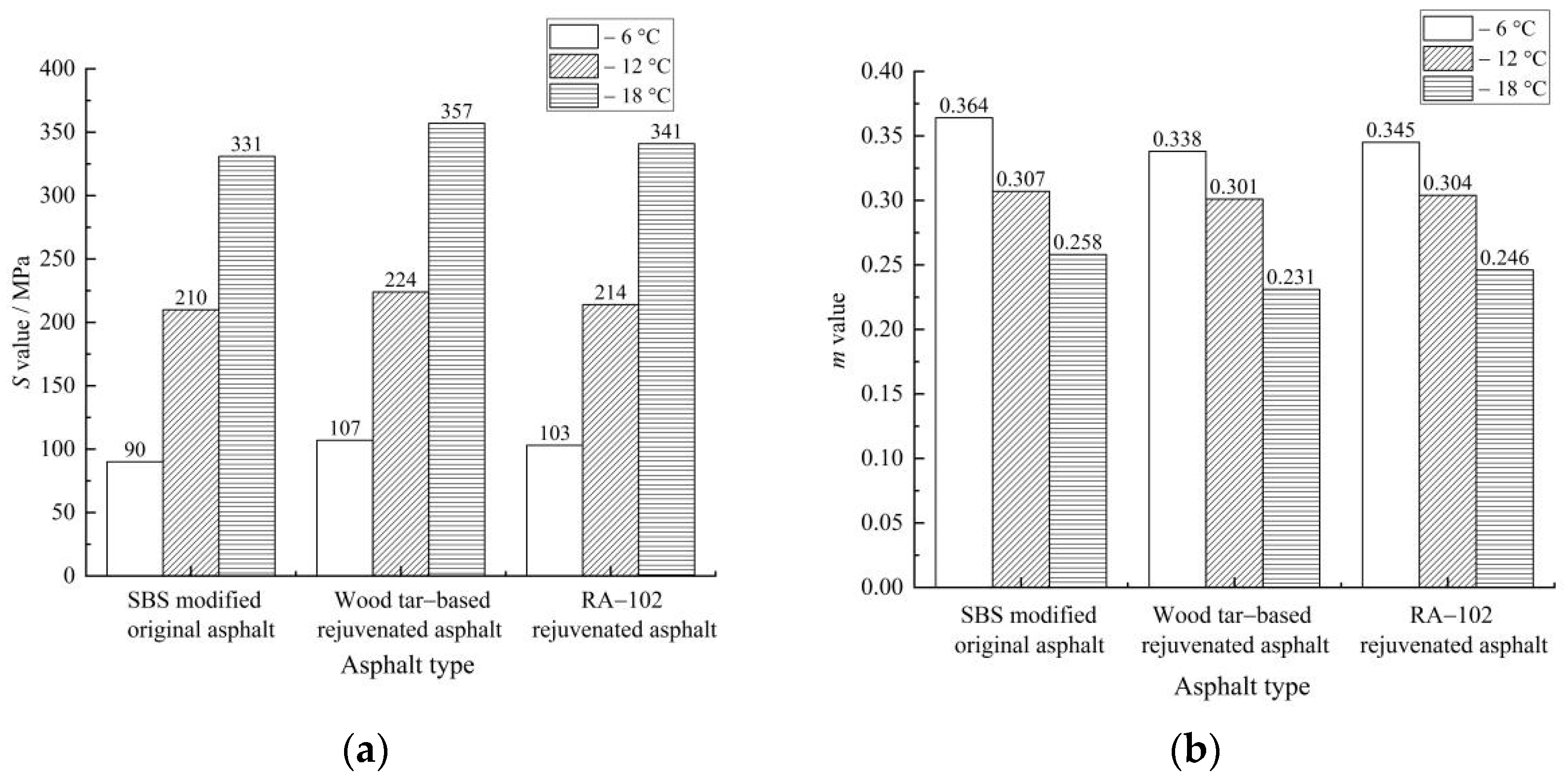
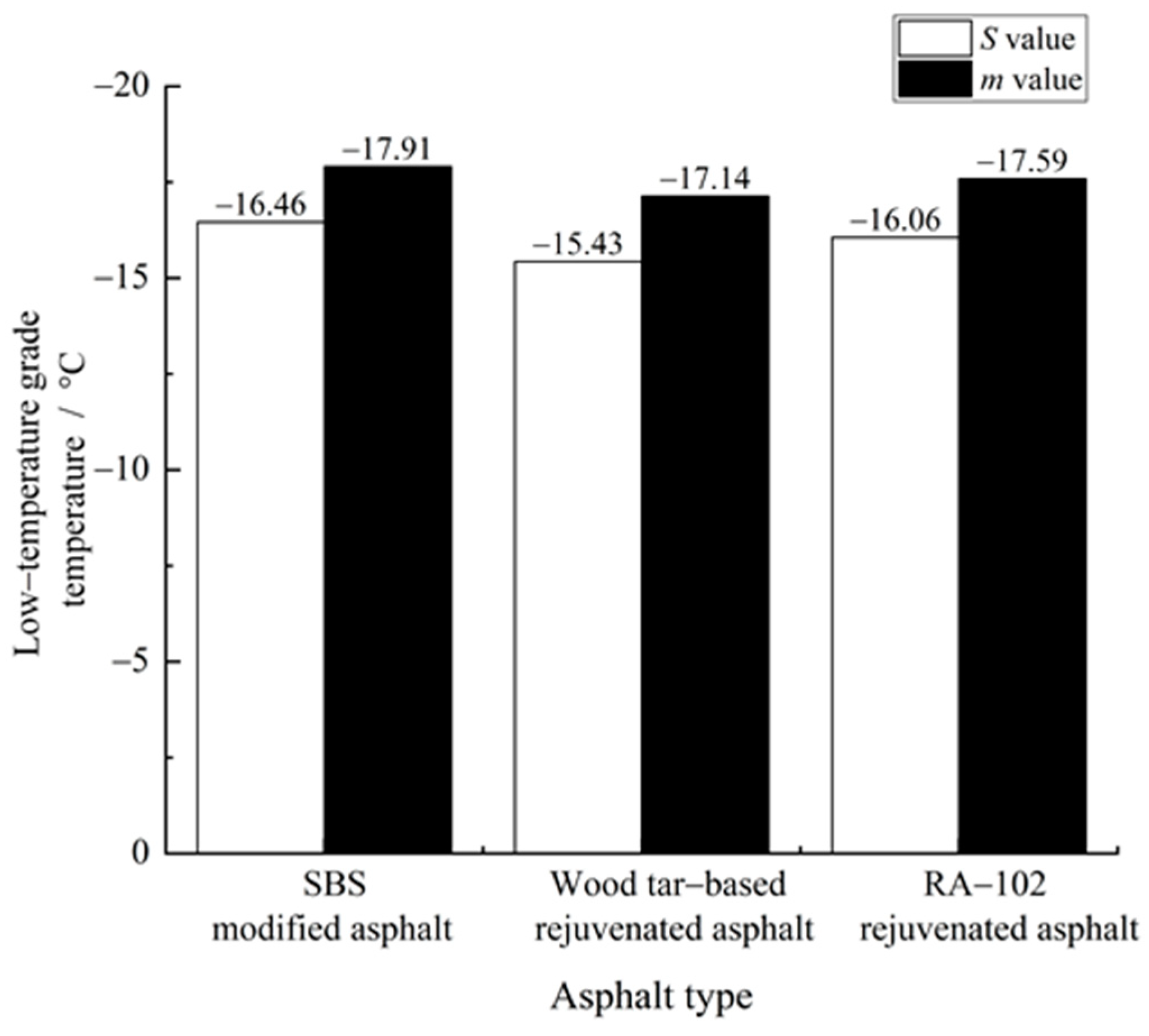


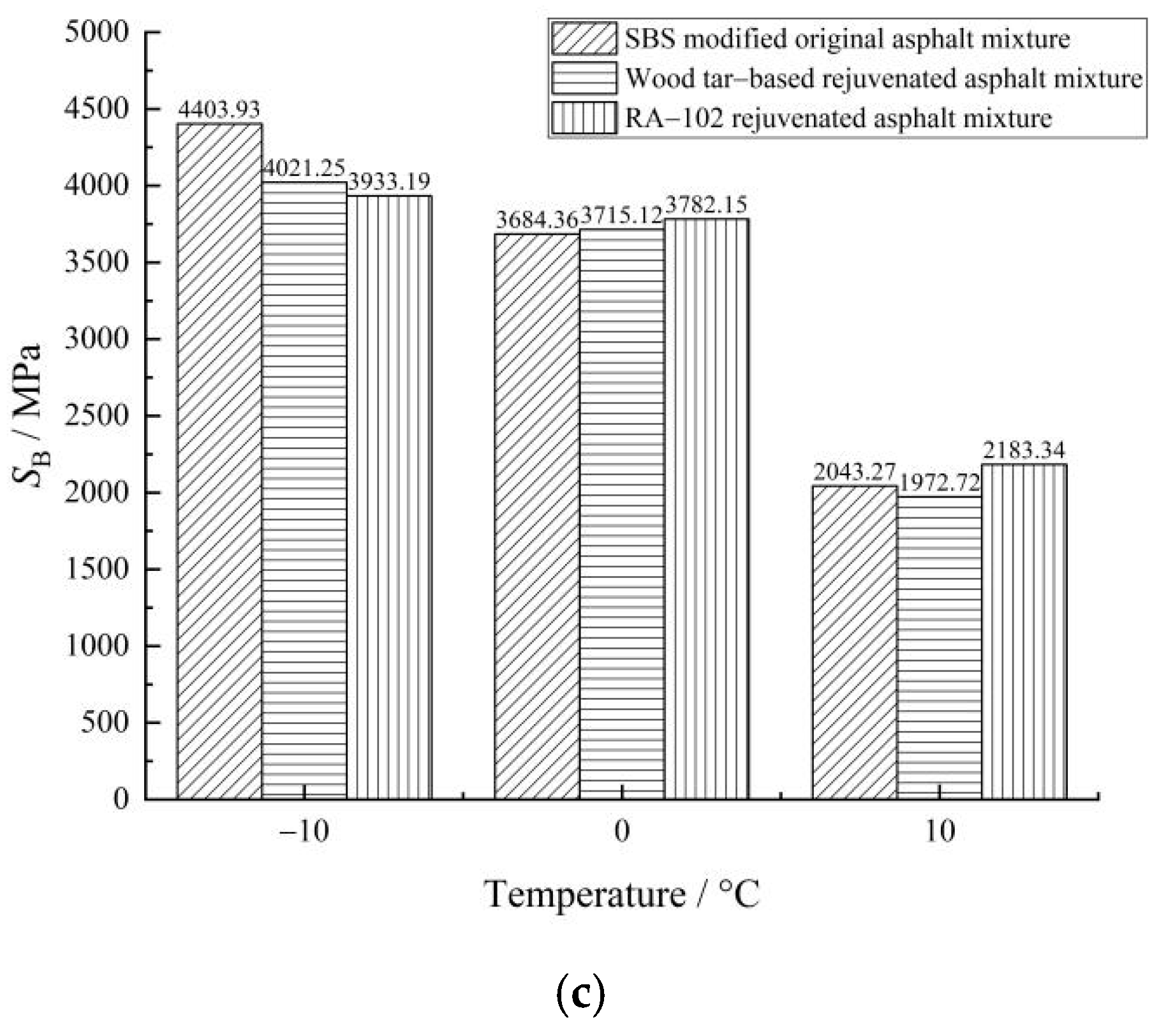
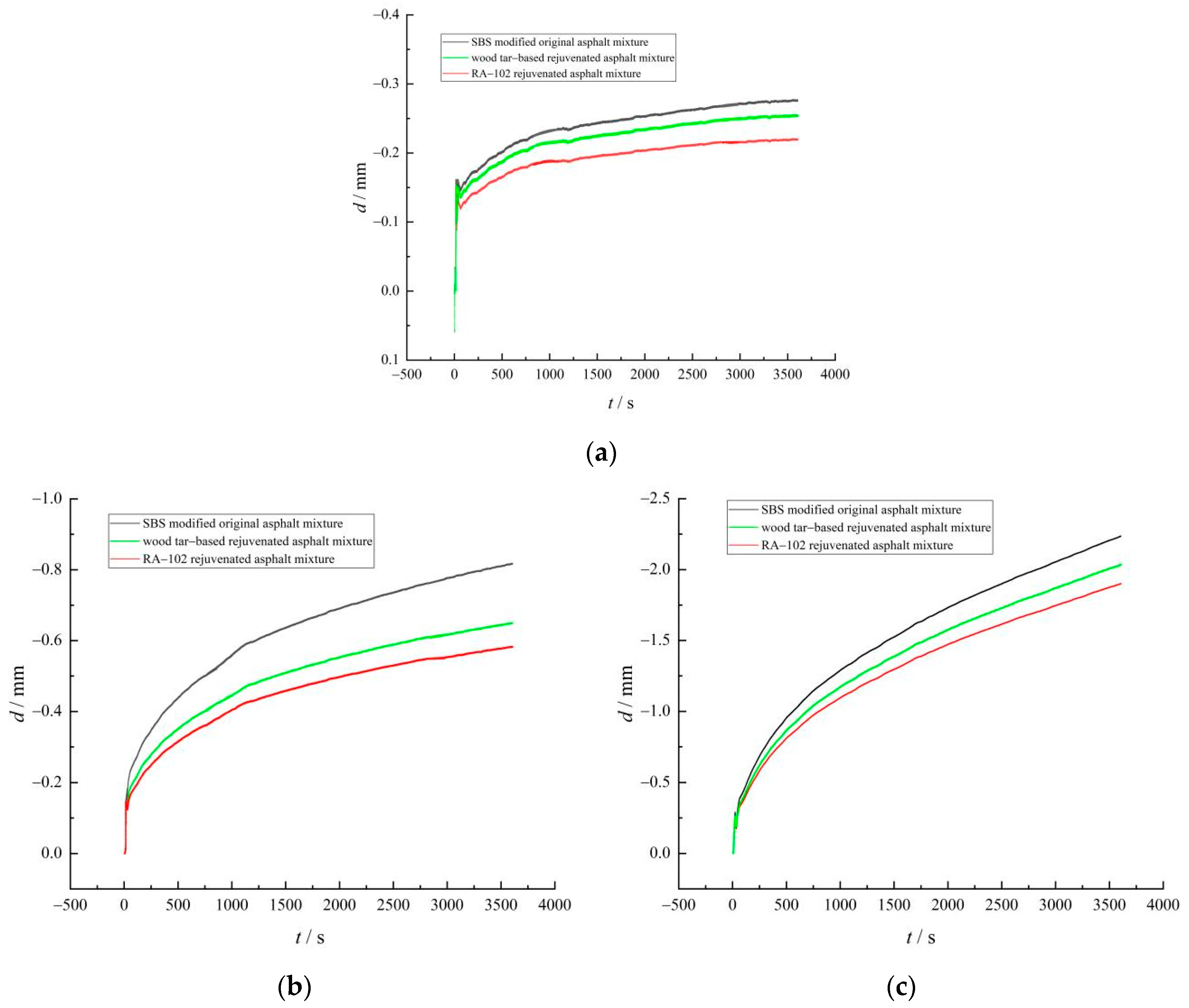
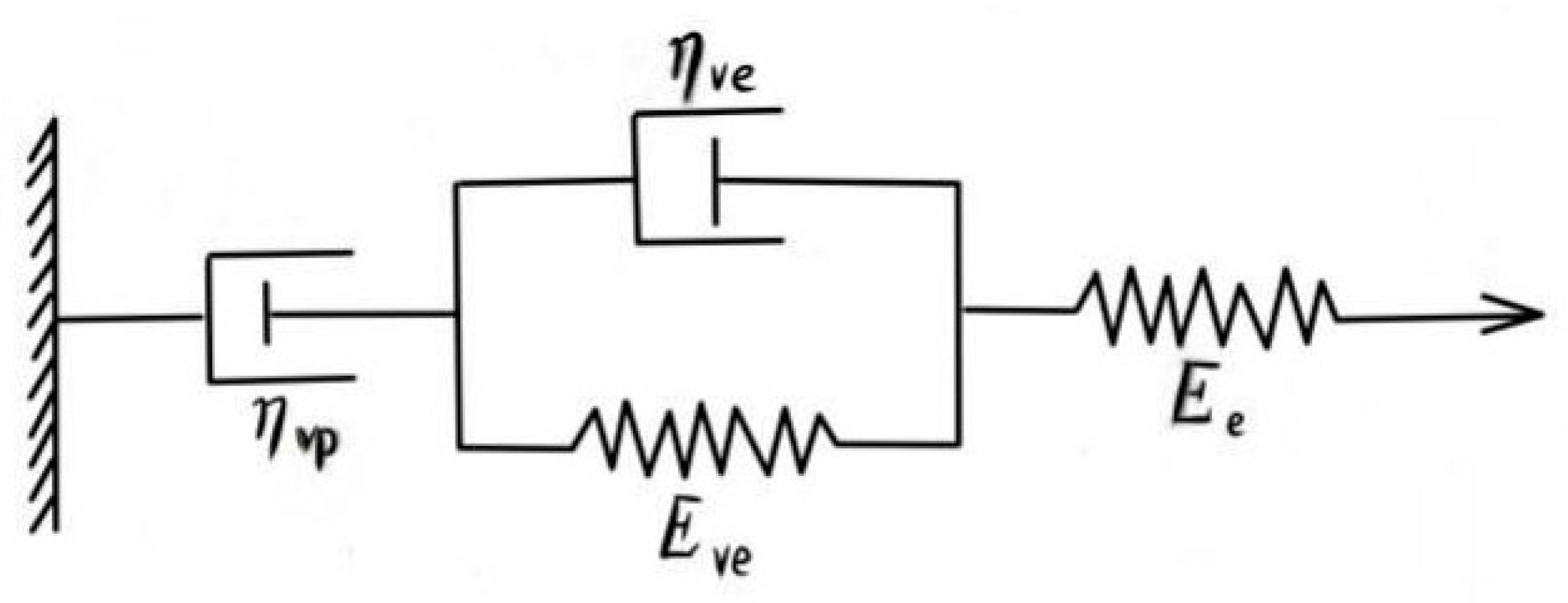
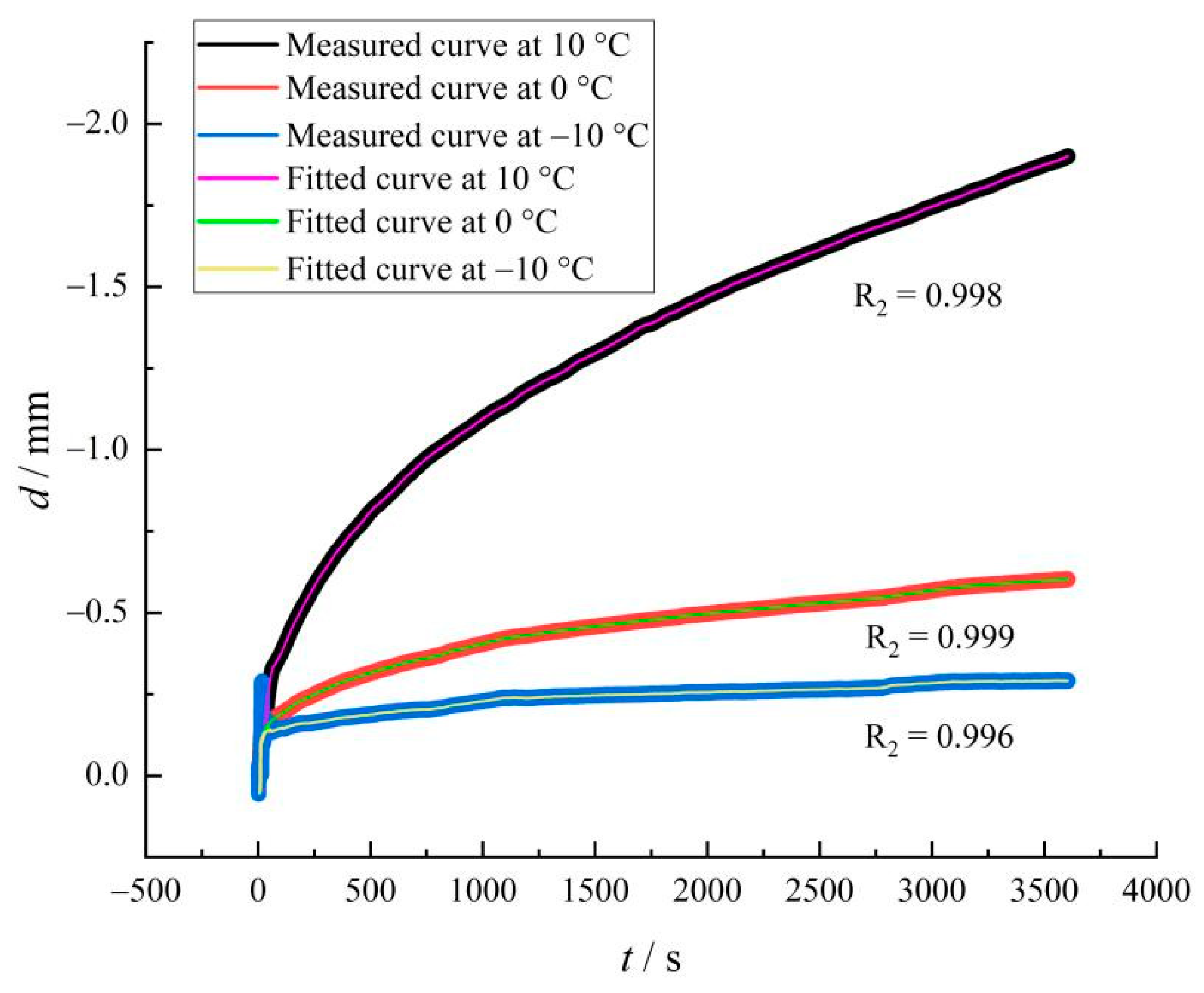
| Asphalt Type | Penetration (25 °C)/0.1 mm | Penetration Index | Ductility (15 °C)/cm | Viscosity (135 °C)/Pa·s | Softening Point /°C |
|---|---|---|---|---|---|
| SBS-modified original asphalt | 66.1 | −1.136 | 117 | 0.34 | 48 |
| RA-102 rejuvenated asphalt | 63.3 | −0.768 | 113 | 0.45 | 55 |
| Wood tar-based rejuvenated asphalt | 63.5 | −0.870 | 102 | 0.47 | 57 |
| Material Type | Moisture Content/% | Density/(g·ml−1) | Relative Density | pH | Length/μm |
|---|---|---|---|---|---|
| Wood tar | 4.2 | 1.15 | -- | 2.14 | -- |
| Biomass fiber | <3.0 | -- | 0.91–0.95 | -- | 400–2000 |
| Technical Index | RA-102 Rejuvenator | Wood Tra-Based Rejuvenator | Specified Value |
|---|---|---|---|
| Viscosity/(60 °C, Pa·s) | 5370 | 4202 | 50–60,000 |
| Flash point/°C | 241 | 213 | ≥220 |
| Saturates content/% | 20.3 | 21.4 | ≤30 |
| Aromatics content/% | 64.2 | 34.2 | -- |
| Viscosity ratio before and after RTFOT * | 1.3 | 1.4 | ≤3 |
| Mass change before and after RTFOT/% | 0.5 | 0.3 | [−3, 3] |
| Technical Index | Test Value | Specified Value | |
|---|---|---|---|
| Crushing value/% | 9.4 | ≤20 | |
| Los Angeles abrasion/% | 10.7 | ≤24 | |
| Polishing value/% | 50 | ≥42 | |
| Apparent specific gravity | 10–16 mm | 2.8053 | ≥2.6 |
| 5–10 mm | 2.8265 | ||
| Water absorption/% | 10–16 mm | 0.458 | ≤2.0 |
| 5–10 mm | 0.679 | ||
| Percent of flat and elongated particles/% | 10–16 mm | 4.5 | ≤10 |
| 5–10 mm | 10.8 | ≤15 | |
| Technical Index | Apparent Specific Density | Sand Equivalent/% | Angularity/s |
|---|---|---|---|
| Test value | 2.7404 | 71 | 50 |
| Specified value | ≥2.5 | ≥60 | ≥40 |
| Technical Index | Apparent Specific Density | Water Content/% | Plasticity Index/% | Hydrophilic Coefficient |
|---|---|---|---|---|
| Test value | 2.714 | 0.4 | 2 | 0.6 |
| Specified value | ≥2.5 | ≤1 | <4 | <1 |
| Test Index | SBS-Modified Original Asphalt | Wood Tar-Based Rejuvenated Asphalt | RA-102 Rejuvenated Asphalt |
|---|---|---|---|
| Flexural tensile stress σB/MPa | 3.142 | 2.946 | 2.565 |
| Flexural tensile strain εB/µε | 2143.7 | 2018.4 | 1733.6 |
| Fracture energy density /kPa | 0.038 | 0.041 | 0.034 |
Publisher’s Note: MDPI stays neutral with regard to jurisdictional claims in published maps and institutional affiliations. |
© 2022 by the authors. Licensee MDPI, Basel, Switzerland. This article is an open access article distributed under the terms and conditions of the Creative Commons Attribution (CC BY) license (https://creativecommons.org/licenses/by/4.0/).
Share and Cite
Liu, K.; Liu, C.; Li, Q.; Jiang, K. Laboratory Investigation of the Low-Temperature Crack Resistance of Wood Tar-Based Rejuvenated Asphalt Mixture Based on the Semi-Circular Bend and Trabecular Bending Test. Materials 2022, 15, 7223. https://doi.org/10.3390/ma15207223
Liu K, Liu C, Li Q, Jiang K. Laboratory Investigation of the Low-Temperature Crack Resistance of Wood Tar-Based Rejuvenated Asphalt Mixture Based on the Semi-Circular Bend and Trabecular Bending Test. Materials. 2022; 15(20):7223. https://doi.org/10.3390/ma15207223
Chicago/Turabian StyleLiu, Kefei, Chonglin Liu, Quan Li, and Kang Jiang. 2022. "Laboratory Investigation of the Low-Temperature Crack Resistance of Wood Tar-Based Rejuvenated Asphalt Mixture Based on the Semi-Circular Bend and Trabecular Bending Test" Materials 15, no. 20: 7223. https://doi.org/10.3390/ma15207223
APA StyleLiu, K., Liu, C., Li, Q., & Jiang, K. (2022). Laboratory Investigation of the Low-Temperature Crack Resistance of Wood Tar-Based Rejuvenated Asphalt Mixture Based on the Semi-Circular Bend and Trabecular Bending Test. Materials, 15(20), 7223. https://doi.org/10.3390/ma15207223




